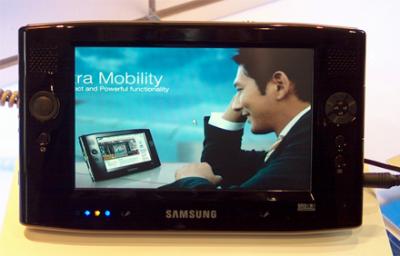Samsung Q1: a first look

Following much speculation and leaked images of varying provenance, the truth about Microsoft's 'Origami' project is now out. Not that the truth comes as all that much of a surprise: first, the company's teaser campaign on www.origamiproject.com rather gave the game away in its source code by identifying Origami as "the Mobile PC running Windows XP"; and second, Intel showed off some concept Origami designs on 7 March at its IDF conference in San Francisco.
By the time Microsoft, Intel and its hardware partners came to deliver some details at CeBIT in Hanover on 9 March, it was clear that an Origami device was bigger than a handheld but smaller than a tablet, powered by standard x86 processors and running some variant of Windows XP. Pre-launch punditry and comment also suggested that the first generation of devices would not match up to the ideal, touted by Bill Gates at the 2005 WinHEC conference, of a fully functional mobile PC with all-day (8-hour) battery life costing around $500.
And that's pretty much what we got. The Origami codename became the Ultra Mobile PC (UMPC) platform; three manufacturers -- Samsung, Asus and Founder (a Chinese company) -- broke cover with UMPC hardware; and battery life was confirmed as a rather disappointing 2 - 3.5 hours. The one price reported so far, around €1,000 (£700) for the Samsung Q1 previewed here, is higher than we would have liked -- especially as a considerable amount of desirable functionality comes in the form of add-ons.

The Samsung Q1 is quite a smart piece of kit: it's mostly shiny black, with silver accents, accommodating a 7in. 800-by-480 (WVGA) TFT touchscreen within its 22.7cm (wide) by 13.9cm (deep) by 2.45-2.65cm (thick) dimensions. It weighs a handy 779g without any external or internal add-ons, is powered by Intel's ultra-low-voltage 900MHz Celeron M processor and comes with 512MB of DDR2 SDRAM in its single DIMM slot. Graphics are handled by the GMA 900 module integrated within the Intel 915GMS chipset, while internal storage comes in the form of a 40GB hard drive. The overall impression of the hardware lies somewhere between a small Tablet PC, a large handheld and a bloated Sony PSP (although the screen isn't as gorgeous as the PSP's).
The operating system is Windows XP Tablet PC Edition, with the addition of Microsoft's new Touch Pack, which provides a number of interface features designed to make stylus- or fingertip-driven operation easier. The Touch Pack's Program Launcher organises applications into categories, using large buttons and icons to simplify the process of finding and launching programs. There's also an innovative Dial Keyboard -- two fan-like arrays of touch-keys on each side of the screen, conveniently placed for thumb typing. Other navigation/interface elements include an 8-way joystick, a four-position user-definable button, enter and menu buttons, and an Auto Scaler button that toggles the screen between its native 800 by 480 and 800 by 600 or 1,024 by 600.
As far as connectivity is concerned, the Samsung Q1 has Wi-Fi (802.11b/g) and Bluetooth (2.0+EDR) built in, along with wired 10/100 Ethernet. There's no wide-area wireless connectivity in the shape of GPRS or 3G, which might have been expected in such an eminently mobile device. So to access the Internet away from an office, home or Wi-Fi hotspot, or to get a GPS fix, you'll need to have a suitable Bluetooth, CompactFlash or USB add-on to hand. Ports and connectors are arranged as follows: on the left is the power connector, a USB 2.0 port and a VGA connector; the right-hand side houses a hold switch, a volume rocker, an audio jack and a powered USB 2.0 port. The dual microphones are on the front fascia, along with the stereo speakers. The top edge houses a dual-mode power and AVS switch (AV Station is a pre-boot application for accessing multimedia content), a reset button, a Type II CompactFlash slot and the Ethernet connector.
The Q1 comes with a useful-looking array of accessories: a keyboard, an organiser bag, an external optical drive, a car cradle and an 8-cell extended-life battery pack. Samsung claims up to 3.5 hours of life for the device using the internal battery, or 'over 1.7 hours' of DVD playback.
First impressions
The Samsung Q1 is an intriguing piece of kit, but some natural selection needs to occur before it can evolve into an indispensable mobile companion. Key functionality such as GPRS or 3G connectivity is not integrated into the device, and battery life is nowhere near long enough at around 3.5 hours. That said, we look forward to a hands-on review of the Q1 and its brethren, and also to charting the development of this new mobile computing platform.
Update (7/4/2006)
Expansys has now made the Q1 available for pre-order on its Web site. The price: £680.81 (ex. VAT; or £799.95 inc. VAT).